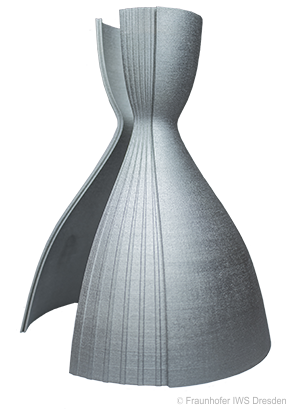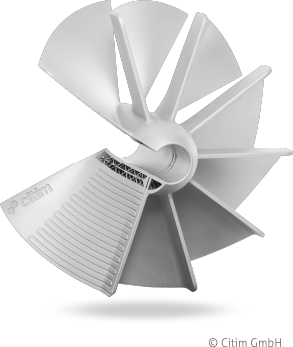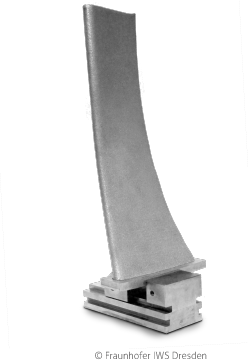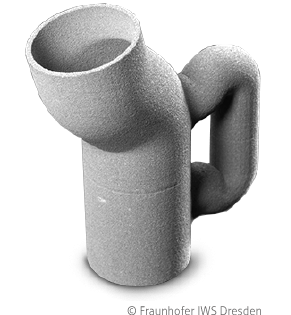Processes
Taking control.

Selective laser sintering (SLS), selective laser melting (SLM), and selective electron beam melting (SEBM) are the preferred procedures when the fabrication of components requires highest geometric degrees of freedom. The workspace of the machine limits the component size to approximately 300 x 300 x 200 mm. The accuracy of the raw material, depending on the process, is in the range of 100 µm and 1 mm. The typical rates are between 2 and 100 cm3/h, depending on the particular procedure and the material. The defect-free, processible range of materials includes steels, nickel and cobalt alloys as well as Ti lightweight materials, hard metals, and ceramics.
The core of our work is the development of Additive Manufacturing technologies based on inks and pastes. We consider the entire process chain starting from the preparation of raw materials, substrate pretreatment, aerosol and dispenser printing, drying, curing, laser and plasma sintering and characterization of the final components. Materials include metals, polymers, ceramics, and composites. Important applications are flexible or conformal thermoelectric generators.
Based on 3D-CAD data models, 3D structures are generated for the direct fabrication, modification or repair of components. The component size is unlimited in this procedure and the smallest lateral resolution is 30 µm. Steels, nickel and cobalt alloys, titanium and aluminum lightweight materials and carbide composites can be processed in a defect-free manner. Currently IWS scientists focus their research into the development of intermetallic titanium aluminides and Ni-based high temperature materials.
Compared to laser powder buildup welding, laser wire buildup welding bears significant advantages such as 100% material utilization, clean processes, high surface quality and a low chemical reactivity due to smaller specific surfaces.
Thanks to the novel IWS COAXwire processing head, wires can now also be processed independent from direction with high geometric degrees of freedom. The smallest lateral resolution is currently 600 µm.
Practically, all commercial wire feeders can be processed. Typical examples are tool and stainless steels, INCONEL625, INCONEL718, TiAl6V4, AlMg5 as well as bronze and Zn-based model alloys.
Laser buildup welding combines accuracy, speed and reliability in order to produce and use high-performance materials. A tailored temperature cycle with an additional heat source are required to prevent the formation of cracks during the manufacturing process.
Such a tailored temperature regime is only possible if the applied induction heating system is supplemented by an additional process-monitoring device. A good example of this is the varying heat distribution during laser movement when producing a turbine blade.
Heat accumulation causes an increased viscosity in the melt pool, thereby inhibiting the layer-wise build up. Insufficient heat input may cause the temperature to drop below the minimum required level.
Therefore, a basic challenge is to precisely regulate the temperature through induction heating and the laser beam. Of course, the temperature distribution will also depend on the component geometry and the surrounding atmosphere.
The consortium AGENT-3D has been able to develop such a temperature monitoring and control system, called hybrid laser technology. This permits a failure-free manufacture of crack-sensitive alloys with complex component geometry.
The temperature monitoring system uses a highly sensitive NIR-camera to observe the metal surface during the process. The hybrid laser system can be precisely regulated and is affordable, two facts that make it useful for industrial applications and attractive to a wide variety of customers.
Stereolitographie
Stereolithography is a rapid prototyping technology in which liquid monomers are solidified by polymerization. The component is stacked from bottom to top and light exposure is used to harden the polymer.
Layer Laminate Manufacturing
The procedure is subtractive-additive rather than purely additive (which is the easiest method to manufacture three-dimensional components). Pre-manufactured films are cut out and joined to create a three-dimensional model. As the layers have to be very thin and positioned precisely, they are first built up layer-by-layer. Subsequently, lasers, hot wires, blades and milling machines are used for contouring. The process is particularly suited to the manufacture of massive components and large models.
Fused Layer Modelling
In this process a solid layer is formed by extracting molten polymers. Liquid materials and pastes are pressed through a jet and accurately applied onto a substrate. Support structures are needed during the process and removed afterwards.
Laser Chemical Vapor Deposition
Chemical cutting is called Laser Chemical Vapor Deposition. Unlike other additive processes, it is used for coating and post-treatment of surfaces. A laser is used to trigger a chemical reaction.


